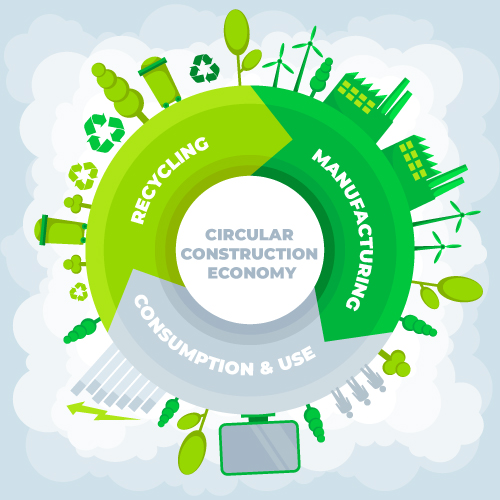From Waste to Resource: BIM's Contribution to a Circular Construction Economy
Optimizing Sustainability: BIM's Role in Shaping a Circular Construction Economy

In today's rapidly changing world, sustainability and resource management have become crucial considerations for the construction industry. With the increasing need to minimize waste and maximize the use of resources, BIM has emerged as a powerful tool that can revolutionize construction planning and management. Whether you are a construction professional or simply interested in the future of sustainable construction, this blog will provide valuable insights into the potential of BIM in contributing to a circular construction economy.
The Role of BIM in the Circular Construction Economy: An Introduction
BIM plays a crucial role in the circular construction economy by providing comprehensive information on the reuse, repair, and recycling of building materials and components at the end of their lifecycle.
Digital modeling for end-of-life in BIM enhances understanding and promotes collaboration and data sharing among stakeholders, enabling them to make informed decisions and adopt effective circular strategies. By providing a visual platform, BIM facilitates a global vision in circular economy principles and promotes stakeholder collaboration. This collaboration and data sharing allows stakeholders to apprehend the environmental and economic importance throughout the whole lifecycle of a structure.
BIM integrates data on material attributes, implementation, and potential end-of-life procedures. This empowers designers to prioritize circularity from the early stages of a project. With comprehensive data on material characteristics, designers can make informed decisions regarding sustainable material selection and prioritize circular design strategies. Data integration also ensures efficient use of material flow and increases trust in circular design strategies by analyzing complex building systems.
Additionally, BIM confounds data management and estimation challenges by simplifying processes and accurately evaluating resource necessities and potential reclamation. This streamlining of methods helps in inventory keeping and facilitates deconstruction purposes. BIM provides a systematic framework to evaluate and quantify the circularity of building designs through circularity assessment. This assessment allows stakeholders to evaluate the environmental and economic effects of different design alternatives, materials, and methods. It fosters a more profound sense of circular economy precepts and their application in construction.
Incorporating circularity inspection in BIM helps management comprehend the issues and challenges of building circularity. The assessment process highlights the potential benefits and challenges associated with circularity in buildings, allowing stakeholders to make more informed decisions. BIM creates a valuable contribution to the circular construction economy by providing comprehensive information and promoting collaboration.
BIM plays a vital role in the circular construction economy by enhancing understanding, streamlining processes, and providing comprehensive information for informed decision-making. It enables the construction industry to embrace circularity and make sustainable choices throughout the lifecycle of a building.
Leveraging BIM for Improved Resource Management in Construction Planning
Leveraging BIM (Building Information Modeling) can significantly impact resource management in construction planning.
BIM allows for the digital representation of a building, encompassing all its components and systems. This comprehensive view of the project enables construction planners to accurately assess and allocate resources such as materials, labor, and equipment. With BIM, planners can optimize the use of resources, leading to more efficient and cost-effective project management.
In addition, BIM facilitates better collaboration and coordination among different stakeholders involved in the construction project. Having a shared platform and access to real-time data allows everyone to stay on the same page and reduces the likelihood of resource conflicts or wastage. This enhanced coordination ultimately leads to smoother project execution.
Furthermore, BIM enables construction planners to simulate and analyze different scenarios. This capability allows for proactively identifying potential bottlenecks or issues, helping optimize resource allocation and mitigate risks before they arise. By having this foresight, construction projects can be better planned and executed.
Moreover, BIM offers real-time tracking and monitoring of resources throughout the construction process. This capability enables proactive decision-making and adjustments, ensuring that resources are utilized effectively and efficiently.
By leveraging BIM for improved resource management, construction companies can enhance productivity, reduce delays, and deliver projects on time and within budget. Integrating BIM in construction planning can revolutionize the industry, providing a valuable contribution to the circular construction economy and sustainable construction practices.
Applying Circular Business Models with BIM: A Step Towards Sustainability
The construction sector plays a significant role in resource extraction, with 40% of all extracted minerals worldwide being used in the built environment. However, there is a growing recognition within the industry of the need to embrace circular business models to reduce waste and promote sustainability.
One notable example of this shift towards circularity is the construction of ABN AMRO's CIRCL pavilion in Amsterdam. The structure of CIRCL was planned and executed as a prime example of "walking the circular talk." The philosophy behind the project was that "doing nothing is no longer an option," and it was seen as an opportunity to showcase the potential of circular business models and building standards.
ABN AMRO's sustainability goals, known as Mission 2030, align perfectly with the philosophy and ambition of CIRCL. The bank is committed to making its real estate portfolio more sustainable and sees circular business models as a valuable contribution to a future-proof society.
The report, "A Future-Proof Built Environment," co-launched by ABN AMRO and Circle Economy, highlights the possibilities and benefits of adopting circular practices in the construction sector. It showcases real-life and practical examples, explicitly focusing on the construction of CIRCL. The insights and best practices gathered from the planning and construction process are cross-referenced to analyze the project comprehensively.
By applying circular business models and leveraging data-supported workflows, the construction industry can achieve improved project efficiency, enhanced understanding of environmental impacts, and better resource management. Tools such as BIM can play a crucial role in facilitating circular construction by enabling better inventory keeping, supporting deconstruction purposes, and promoting sustainable construction practices.
The report also emphasizes the importance of a materials passport and aggregated circularity indicators for effective construction planning and management decision-making. Additionally, BIM can contribute to improved visualization and coordination, leading to more efficient and sustainable construction processes.
Overall, the report catalyzes radical change in the construction sector. It aims to inspire and encourage other companies in the built environment industry to embrace circular business models for their economic benefits and the positive social and environmental outcomes they can bring about.
Enhancing Construction Management through Data-Supported Workflows in the Circular Economy
As the construction industry embraces the principles of the circular economy, data-supported workflows are emerging as a valuable tool for enhancing construction management. The circular economy aims to minimize waste and maximize resource efficiency, and construction projects play a significant role in achieving these goals.
By leveraging data and analytics, construction managers can optimize material usage, reduce waste, and improve overall project efficiency. Digital tools and technologies enable real-time data collection, analysis, and decision-making, leading to more sustainable construction practices. For example, BIM can be used throughout the entire lifecycle of a project, from the planning and design stages to construction and management. BIM provides an enhanced understanding of the project, allowing for improved visualization, coordination, and resource management.
Data-supported workflows also facilitate collaboration and communication among project stakeholders, ensuring seamless coordination and timely project delivery. By sharing data in a centralized platform, all parties involved in the construction process can access up-to-date information, making informed decisions and avoiding costly delays.
Implementing data-supported workflows in construction management has numerous benefits. It results in cost savings, increased project profitability, and reduced environmental impact. Case studies and real-world examples demonstrate the successful implementation of these workflows in construction projects within the circular economy. For instance, the Circular EcoBIM project developed aggregated circularity indicators that measure the environmental impacts of construction materials and processes. This data enables construction managers to make informed decisions prioritizing sustainability and resource efficiency.
Measuring Circular Progress: Aggregated Circularity Indicators in the Circular EcoBIM Project
The Circular EcoBIM Project is at the forefront of measuring circular progress in the construction industry. This project aims to develop aggregated circularity indicators to effectively measure and track progress towards circularity in buildings and infrastructure projects.
By creating comprehensive indicators, the Circular EcoBIM Project provides stakeholders with a holistic view of the circularity of their projects. This collaborative effort involves researchers, industry professionals, and policymakers dedicated to driving the adoption of circular practices in the construction and infrastructure sectors.
Developing these indicators enables stakeholders to assess their projects' environmental, social, and economic impacts. This information provides valuable insights that can inform decision-making and promote more sustainable and circular construction practices.
Furthermore, the Circular EcoBIM Project is working towards establishing a standardized framework for measuring circular progress. This framework promotes consistency and comparability across projects, enhancing the understanding of circularity and facilitating the implementation of circular business models.
The findings and indicators generated by the Circular EcoBIM Project will contribute to the development of circular economy policies and practices in the construction and infrastructure sectors. This project aims to improve visualization, coordination, and resource management in construction planning and management by measuring circular progress and providing data-supported workflows.
Overall, the Circular EcoBIM Project is making a valuable contribution to the construction industry by promoting sustainable and circular construction practices. This project is driving radical change by developing aggregated circularity indicators and creating a more sustainable and circular built environment.
In Conclusion
BIM has proven to be a game-changer in the construction industry, particularly in the circular economy. By leveraging BIM for improved resource management, applying circular business models, enhancing construction management through data-supported workflows, and measuring circular progress, we can pave the way for a more sustainable and efficient construction industry. The potential of BIM to transform waste into valuable resources is immense, and it is up to professionals in the construction industry to embrace and harness this technology to contribute to a circular construction economy. As we strive for a more sustainable future, BIM will undoubtedly play a vital role in reshaping how we plan, design, and construct our built environment. Together, we can work toward a future where waste becomes a resource, and the construction industry becomes a driving force for a circular economy.
Source: https://articles.abilogic.com/649429/waste-resource-bim-contribution-circular.html
+ Post an article












